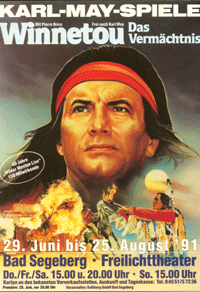Most people aren't aware that Germans love cowboys and Indians. Salon (11/27/02) explains how this love affair came about:
German obsession with the American frontier exploded in 1896 when huge crowds were drawn to Buffalo Bill's Wild West Show, which toured Europe. At about the same time, an eccentric German schoolteacher wrote a series of pulp novels about the exploits of Winnetou and Old Shatterhand. The Apache warrior and his German frontiersman blood-brother roamed the Great Plains fighting bears, rattlesnakes and the injustices of land-hungry pioneers. The author, Karl May, penned some of his work while in prison for fraud and never visited the West. Although the details are often comical (Apaches living in pueblos?), more than 100 million copies of his books have been sold, according to the Karl May Museum. His fans included Adolf Hitler, Herman Hesse and Albert Einstein. The characters are still so popular that some Germans name their children Winnetou.
"Historically, many Germans have been captivated by American culture, from the lore of the West to jazz to modern methods of production," said Remy. "But there's also a more ominous explanation. I think it represents the long-standing German fascination with and fear of frontiers. There may be a parallel between the conquest of the West and its sometimes violent clash of cultures and Germany's drive for expansion and a 'new order' in the first half of the 20th century."When I wrote an essay titled
Adolf Hitler: A True American, I noted that Hitler was familiar with US history. I also quoted someone who noted Hitler's love of Karl May's books. To me the implication was obvious: the American holocaust at least partially inspired the Holocaust.
Unfortunately for me, a Dutch defender of Karl May and Winnetou wrote to say I was wrong. Unfortunately for him, I was right. I read the first book in the series to confirm that yes, May's message was one of Aryan supremacy.
We've been debating this subject off and on since July 2001. The latest installments are now online. This argument is long and perhaps tedious, but if you want to check it out, it's
here.



1 comment:
I presume Hitler was the prime instigator of the Holocaust against the Jews. I doubt many Germans were thinking about genocide before he filled their minds with propaganda. They were merely following orders, going along—the "banality of evil" and all that.
So what matters here is Hitler's mindset, not the mindset of the average German. But I addressed your implied point—that Germans seemed to have a positive view of Indians—several times. Here's one of my responses:
Americans had a romantic view of Indians before Karl May wrote his books: The noble savage. Pocahontas, who saved Captain Smith. Squanto, who helped the Pilgrims. Chingachgook and Uncas, the faithful companions of Natty Bumppo. Sacagawea, the faithful companion of Lewis and Clark. Hiawatha. Minnehaha. Ramona.
This didn't change the overriding American view of Indians as savages, marauders, and killers. In fact, it helped cement it. We mythologized a few good Indians as paragons of virtue. We placed them firmly in the distant past, where they couldn't affect contemporary political policy. (Note that May's books are set in the early, pioneering phase of the American West, before the land was largely settled.)
We contrasted these few romanticized, legendary Indians with the unnamed and unlamented masses of Indian people. Who were these anonymous "braves," "squaws," and "papooses"? Well, they weren't larger-than-life heroes like Chingachgook or Winnetou, so they didn't matter. We could safely dismiss them as unworthy of our attention—inconsequential and irrelevant.
The good Indians were mostly gone except in our memories and stories (books, illustrations, movies). The remaining Indians didn't deserve anything because they weren't unnaturally brave and noble. In other words, they didn't live up to the imaginary standard set by the non-Indians' Indian heroes. They were good-for-nothing heathens, scalawags, drunks, and beggars.
This attitude toward Indians continues today. We see it most often in the mascot debate. We "honor" the Indians of yesteryear by depicting the most exceptional examples—the mighty chief, the fierce warrior, the beautiful maiden—and ignoring the rest. By freezing the Indians in amber, locking them up in a museum, we don't have to deal with their continuing reality. We especially don't have to deal with our role in their continuing reality: the genocide, the broken treaties, the generations of oppression and neglect.
May's books are more of the same. May focused on Winnetou as the exception to the rule. The superhumanly "good Indian" didn't tell us that all Indians were good. Paradoxically, it told us that most Indians were neutral or bad, because they didn't live up to the "good Indian" standard.
Post a Comment